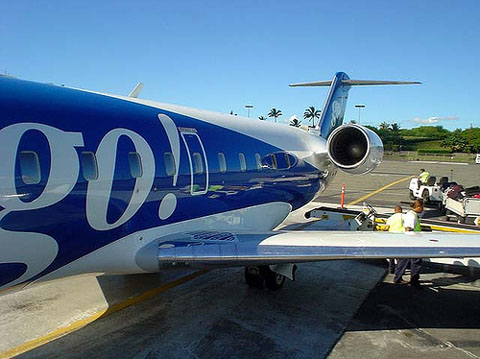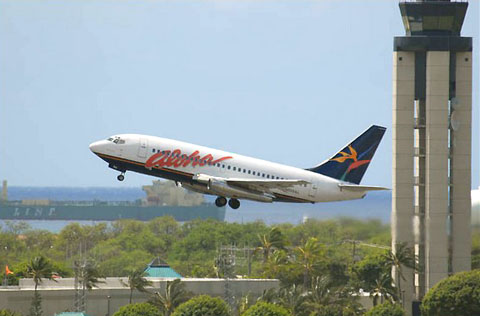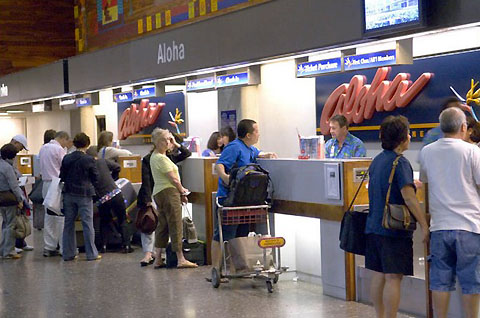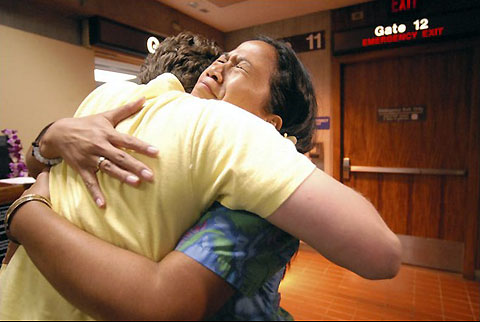www.islandbreath.org ID#0809-16
SUBJECT: AIRLINES COLLAPSE
SOURCE: BRAD PARSONS mauibrad@hotmail.com
POSTED: 14 APRIL 2008 - 9:30am HST
Mesa and Go! down for the count

image above: go! plain loading on the tarmac in Hawaii
by Brad Parsons on 12 April 2008 I think it can be said that the markets are expecting Mesa's and Go's failure. The stock price is pretty low right now, maybe too low. I think this all depends if Mesa can convince current shareholders and current and new investors of the efficacy of a new stock issue for $38 million. Without that, I think they do fail...along with Go! There were a number of good articles recently on this matter. 'HONOLULU (AP) - Shares of the parent company of go! airlines has tumbled to close at a 52-week low. The fall came after Calyon Securities analyst Ray Neidl said he was dropping coverage of the Phoenix-based Mesa Air Group Inc. because of its small market value. |
SUBJECT: FUEL & PROFITS
SOURCE: BRAD PARSONS mauibrad@hotmail.com
POSTED: 5 APRIL 2008 - 3:30am HST
It's all about the fuel, guys

image above: Gounded Aloha Airlines jet on Maui. Photo by Amanda Cowan
by Brad Parsons on 5 April 2008 See more http://hisuperferry.blogspot.com
|
SUBJECT: ALOHA GOES BELLY UP
SOURCE: ELAINE DUNBAR inunyabus@gmail.com
POSTED: 1 APRIL 2008 - 8:00am HST
Letter to HI Legislature on Aloha Airlines

image above: Last day of flight for Aloha Airlines. Photo by Gregg Yamamoto (Honolulu Advertiser)
by Elaine Dunbar on 31 March 2008
|
SUBJECT: ALOHA GOES BELLY UP
SOURCE: JUAN WILSON juanwilson@mac.com
POSTED: 1 APRIL 2008 - 8:00am HST
Sad farewell to Aloha Airlines

image above:Final line for tickets. Photo by Gregg Yamamoto (Honolulu Advertiser)
| Editorial on 1 April 2008 in The Honolulu Star Bulletin After 61 years, Aloha Airlines has terminated its passenger service. Aloha Airlines' announcement that it was going out of business should have come as a surprise to no one. The airline had been flying in the red while engaged in a fierce fare war for more than two years, and a surge in fuel prices forced it to land in bankruptcy, with no buyers emerging. Interisland travelers will miss Aloha's 61-year presence. "Unfortunately, unfair competition has succeeded in driving us out of business," said David Banmiller, Aloha's president and chief executive. The remark was aimed at Mesa Air Group's go!, which arrived in Hawaii in June 2006 and began offering $19 interisland one-way fares and promotional fares that dipped as low as $1 last year. However, Aloha had experienced financial problems before Mesa's arrival, having filed for bankruptcy in 2004, following the path of Hawaiian Airlines. Both carriers emerged from bankruptcy before go! entered the island skies. Having lost $41.2 million in 2005, Aloha proceeded to report losses of $46 million in 2006 and $81 million last year. It lost $11 million this January alone. Fuel prices rose in recent months as the dollar weakened, damaging airlines trying to cope with an economy that increasingly is being recognized as a recession. Rep. Neil Abercrombie has called for the release of fuel from the petroleum reserve in response to what he regards as a national emergency. The closure will result in the layoff of 1,900 Aloha employees, although 1,600 may keep their air cargo jobs. Saltchuk Resources Inc., the Seattle-based parent of Young Bros. Ltd., offered to buy the air cargo operation last week for $13 million. United Airlines, Aloha's marketing partner, may have backed away from a proposal involving ATA and Mesa to save the airline's passenger service. Several industry experts anticipated Aloha's announcement. "It will be very difficult to maintain three interisland carriers," aviation industry consultant George Hamlin told the Star-Bulletin's Jennifer Sudick after Aloha's latest bankruptcy filing on March 20. "You can either have two fat cows or three skinny ones." Mesa appears determined to keep go! flying in Hawaii, although a federal judge ordered it to pay more than $80 million for using confidential information obtained during Hawaiian's bankruptcy. Mesa has posted a $90 million bond to appeal the ruling. Hawaiian has been able to cope with the price war, posting a $7.1 million profit last year. Competition between Hawaiian and go! should continue, but not at a level that could put either airline out of business. The worst scenario would leave the state with only one interisland airline. |
SUBJECT: ALOHA GOES BELLY UP
SOURCE: JUAN WILSON juanwilson@mac.com
POSTED: 1 APRIL 2008 - 8:00am HST
Aloha's final flight 261

image above: Last hug for Aloha passenger. Photo by Andrew Shimabuku (Honolulu Advertiser)
| by Christie Wilson on 1 April 2008 in The Honolulu Advertiser A rowdy crowd of several hundred Aloha Airlines employees, airport workers, family members, friends and supporters greeted passengers and crew from Aloha Flight 261 after it touched down at Honolulu International Airport at 10:32 p.m. yesterday, the final regularly scheduled passenger flight for the "people's airline" that served Hawai'i for 61 years. It was a flight like no other, and more than half of the 80 people aboard were Aloha employees who cheered, clapped, wept, sang and offered testimonials over the public address system during the 22-minute flight from Kahului. Most had boarded in Honolulu for a quick roundtrip to Maui. Captain Mike Uslan, one of several Aloha pilots who accompanied family members on the flight, offered a toast of Pass-o-Guava juice in small plastic cups with the foil covers: "To Aloha — the last of the good airlines." Uslan also offered a parting shot to rival go! airlines, which has been blamed for igniting an airfare war that contributed to Aloha's demise: "For all your travel needs in the Hawaiian Islands, please fly Hawaiian! Don't fly go!" Captain Mike Moore offered a toast "to friends, family and fond memories with Aloha." Moore was to have piloted the last flight but relinquished the cockpit at the last minute to Darryll Wong, Aloha's most senior pilot, who joined the company in 1976. Other crew members on Flight 261 were first officer Tasha Kobashigawa and flight attendants Renee Jewell, Steve Oshiro and Tori Swoish, who told passengers at the trip's conclusion, "It's the end of an era but I don't think anyone is going to forget us soon." The airline's last paying passengers included Erika Pang Harrison and Sherry Saito of Pearl City, who said they decided on the spur of the moment to fly to Maui yesterday afternoon specifically to catch the last flight "and participate in history." The two physicians said they couldn't get through to Aloha's reservation line, so they just showed up at Honolulu International Airport hoping to get seats. Pang Harrison's husband, Bill, worked as an Aloha flight attendant while in college, and her sister, Monika Pang, is a 31-year flight attendant for the airline. Saito also has strong ties to the airline. "Whenever it was family vacation, we all flew Aloha. It was always Aloha," she said. Saito said she wanted to be on the last flight "for closure, to say goodbye to people and to thank them." The two friends, who picked up Krispy Kreme doughnuts on Maui to bring back to Honolulu, took photos with Aloha flight crews and other employees they encountered throughout the day, and collected souvenirs such as ticket stubs and a plastic cup emblazoned with the Aloha logo. "I feel sad but kind of excited to be participating. It's kind of like a piece of history," Pang Harrison said. Another Flight 261 passenger, Rudy Savio, 24, of Honolulu, estimated he had flown on the airline 270 times and had kept a diary of all his plane travels since childhood. Savio also owns an extensive collection of airline memorabilia, including old flight timetables, ticket jackets and 25 Aloha Airlines T-shirts. "I've always loved flying every since I was a kid, and we've always flown Aloha so I've gotten attached to it," he said. "It's like the end of an era. It's important for me to be here. Aloha has been a big part of my life and I've become friends with a lot of the employees and I wanted to show my support on the last flight." James Guzzo of Kailua, O'ahu, said he flew Aloha 400 times a year for his Endless Pools business. He flew in from Kona to board Flight 261. "There's no way I was going to miss this," he said. Those arriving at Honolulu Airport on the final flight were treated as returning heroes, as dozens of ramp workers waved and cheered when the Boeing 737-200 pulled up to the gate and all aboard received hugs and high-fives from the waiting crowd. After an emotional rendition of "Hawai'i Aloha," the crowd had yet to disperse by 11:30 p.m., no doubt reluctant to bid aloha to co-workers and their careers. |
SUBJECT: ALOHA GOES BELLY UP
SOURCE: JUAN WILSON juanwilson@mac.com
POSTED: 1 APRIL 2008 - 8:00am HST
The Airlines are dying!
by James Kunstler on 31 March 2008 in www.kunstler.com It was not a good week to be at the mercy of America's floundering air travel program. The price of aviation fuel is killing them. They can't fire any more employees or shed anymore pension obligations. There is no elasticity left in the system. Coming back from Denver yesterday, the chaos at the concourse gates was impressive. Nobody knew when or if a given flight would board, and they certainly didn't post any realistic information on the high-def screens at every gate. When asked for updates, the harried gate agents could offer none. So much for computer wizardry. It is interesting to see how passively the public accepts this. For now, they slump like war refugees in the blow-molded plastic seats, numb with fatigue, anxiety, and disappointment. But I wonder if there will be riots in the concourses sometime later this year. |